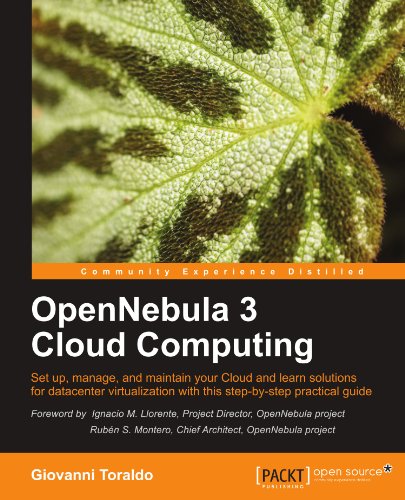

Most ebook files are in PDF format, so you can easily read them using various software such as Foxit Reader or directly on the Google Chrome browser.
Some ebook files are released by publishers in other formats such as .awz, .mobi, .epub, .fb2, etc. You may need to install specific software to read these formats on mobile/PC, such as Calibre.
Please read the tutorial at this link: https://ebookbell.com/faq
We offer FREE conversion to the popular formats you request; however, this may take some time. Therefore, right after payment, please email us, and we will try to provide the service as quickly as possible.
For some exceptional file formats or broken links (if any), please refrain from opening any disputes. Instead, email us first, and we will try to assist within a maximum of 6 hours.
EbookBell Team

5.0
60 reviewsSet up, manage, and maintain your cloud and learn solutions for datacenter virtualization with this step-by-step practical guide
In Detail
OpenNebula is one of the most advanced and highly-scalable open source cloud computing toolkits. If you ever wanted to understand what Cloud Computing is and how to realize it, or if you need a handy way to manage your messy infrastructure in a simple and coherent manner, this is your way.
OpenNebula 3 Cloud Computing guides you along the building and maintenance of your cloud infrastructure, providing real-world examples, step-by-step configuration and other critical information. The book keeps you a step ahead in dealing with the demanding nature of cloud computing and virtual infrastructure management using one of the most advanced cloud computing toolkits– OpenNebula. The book takes you from a basic knowledge of OpenNebula to expert understanding of the most advanced features.
The book starts with a basic planning of hardware resources and presents the unique benefits of the supported hypervisors; you will go in deep with day-to-day management of virtual instances, infrastructure monitoring and integration with Public Clouds like Amazon EC2.
With this book you will be able to get started with fast and cheap configuration recipes, but also go deeper for a correct integration with your existing infrastructure.
You will deal with well-know virtualization technologies like Xen and VMware, but also with the promising KVM technology integrated in the Linux kernel. After the basic infrastructure set-up, you will learn how to create and manage virtual instance via both command-line and web interfaces, and how to monitor your existing resources.
At the end, the book acquaints you with integrating your local infrastructure with external Cloud resources but also publishing your resources to others via common API interfaces.
What you will learn from this book
Approach
This is a step-by-step practical guide to get you started easily with openNebula. It guides you to build, maintain, and configure your cloud infrastructure, providing real-world examples in a simple and coherent manner.
Who this book is written for
If you are a GNU/Linux system administrator with no experience with virtualization or cloud computing but eager to learn about it, or you are thwarted by your current virtualized infrastructure, this book is for you. You are expected to have some basic knowledge of GNU/Linux, with knowledge of basic package management tools and system configuration.